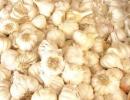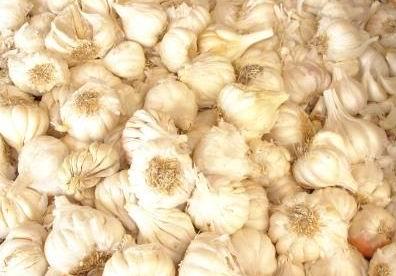
|
Plant extract: Garlic
Scientific name:
Allium sativum
Garlic can be used against the following pests and diseases (clicking on underlined diseases takes you to diseases' page):
African bollworm, downy mildew, fruit rots, rusts, blights, African armyworm, onion thrips, root knot nematodes, anthracnose, rice blast
|
| Standard Procedures for the Preparation and Application of the Plant Extracts | Garlic Bulb Extract III | |||
| Garlic Bulb Extract | Information Source Links | |||
| Garlic Bulb Extract II |
Standard Procedures for the Preparation and Application of the Plant Extracts
Garlic is widely cultivated and easy to grow in field, garden or backyard. It is appreciated as a seasoning or condiment for cooking and due to its medicinal properties. Its value as a pesticide is also appreciated particularly in organic farming and cultivation in the backyard gardens. There are commercial pesticides containing garlic as an active ingredient, and homemade extracts are widely used.
Garlic has anti-feedant (insect stop feeding), bacterial, fungicidal, insecticidal, nematicidal and repellent properties.
Garlic is reportedly effective against a wide range of disease-causing pathogens and insects at different stages in their life cycle (egg, larvae, adult). This includes ants, aphids, armyworms, diamondback moth and other caterpillars such as the false codling moth, pulse beetle, whitefly, wireworm, khapra beetle, mice, mites, moles, Epilachna beetles, and termites as well as fungi bacteria and nematodes.
Garlic is non-selective; it has a broad-spectrum effect and can kill beneficial insects as well. Therefore, it should be used with caution. It is not recommended for aphid control since it kills the natural enemies of aphids. Adult ladybird beetles seem not to be affected by garlic sprays (Ellis et al. 1992) (Brooklyn Botanic Garden, 2000). Drenching with garlic extracts to control soil nematodes, although effective, should be avoided since it may also kill many beneficial soil bacteria and insects.
When growing garlic for pest control, it has been recommended avoiding use of large amounts of fertilisers. This is because heavy doses of fertiliser reduce the concentration of the effective substances in the garlic (HDRA).
General recommendations for preparing and using garlic extracts:
1. Select plant parts of garlic which are free from diseases.
2. Store garlic bulbs in a cool, dry shady place. The most common practice for storing garlic is to braid the dry tops and let the bulbs cure while hung up in the tops. Another method is storing in a single layer in a well-ventilated shady and dry place as practised for onions.
3. Use clean utensils and make sure they are cleaned again directly after use
4. Do not have a direct contact with the crude extract while in the process of the preparation and during the application.
5. Make sure that you place the plant extract out of reach of children and house pets while leaving it overnight.
6. The taste of garlic will remain on sprayed plants for some time after spraying so it may be best to avoid spraying near harvest time, or to harvest all the mature and ripe fruits on the crop to be sprayed before plant extract application.
7. Try out different strengths of the garlic extract to determine effective dosages for specific pests.
8. Always test the plant extract formulation on a few infested plants first before going into large scale spraying. When adding soap as an emulsifier, use a potash-based one like laundry soap (e.g. gun soap).
9. Wear protective clothing while applying the extract.
10. Wash your hands after handling the plant extract.
Garlic Bulb Extract
Materials:
2 garlic bulbsFew drops of soap
4 cups of water
Grinder or knife
Strainer
Bottle container
Methods of preparation:
Grind garlic. If you do not have a grinder, chop garlic. Allow mixture to stand for 24 hours.
Add water and stir in the soap.
Store in a bottle container.
Strain before using.
How to use:
Dilute 1 part of the emulsion with 9 parts of water. Shake well before spraying.
Spray thoroughly on the infested plant, preferably early in the morning.
Effect on humans: None
Effect on non-target organisms: Garlic oil spray has a broad-spectrum effect. It is non-selective so it can kill beneficial insects as well. This is not recommended for aphid control since it kills the natural enemies of aphids. It should be limited to home and garden applications where natural controls are rarely present.
Adult lady beetles seem not to be affected by garlic sprays (Ellis et al. 1992; Brooklyn Botanic Garden, 2000)
Garlic Bulb Extract II
Used against the following pests and diseases:
African bollworm, African armyworm, onion thrips, root-knot nematodes, anthracnose, downy mildew, rice blast. Materials:
85 grams of chopped or crushed garlic50 ml of mineral oil (vegetable oil)
10 ml of liquid dish soap
950 ml of water
Strainer
Bottle container
Methods of preparation:
Add garlic to vegetable oil.Allow mixture to stand for 24 hours.
Add water and stir in the soap.
Store in a bottle container.
How to use:
Dilute 1 part of the emulsion with 19 parts of water (for example, 50 ml of emulsion to 950 ml of water). Shake well before spraying.
Spray thoroughly on the infested plant, preferably early in the morning.
(adapted from Vijayalakshmi et al. 1999; Ellis et al. 1992)
Garlic Bulb Extract III
Ingredients:
100 g garlic cloves
0.5 litres of water
10 gm soap
2 teaspoons mineral oil
Steep the finely grated garlic for 24 hours in the mineral oil. Dissolve the soap in the water, mix the infusion of garlic and mineral oil, stir well together and filter through a fine cloth. Before use dilute this solution with 20 parts of water.
The following preparation is successful against caterpillars in fruit trees:
2 finely grated garlic bulbs and 2 spoon chilli pepper powder are stirred into 4 litres of hot water in which a nut-sized piece of soap has been dissolved.
Information Source Links
- Brooklyn Botanic Garden. (2000). Natural disease control: A common-sense approach to plant first aid. Handbook # 164. Brooklyn Botanic Garden, Inc. 1000 Washington Avenue, Brooklyn, NY.
- Ellis, B. W. and Bradley, F.M. (1992). The Organic Gardener's Handbook of Natural Insect and Disease control. Rodale Press. ISBN 0-87596-753-1
- HDRA - the organic organisation. How to Use Garlic as a Natural Pesticide. www.hdra.org.uk
- Howtopedia. How to Use Garlic as a Natural Pesticide www.howtopedia.org
- OISAT: Online Information Service for Non-Chemical Pest Management in the Tropics. www.oisat.org
- Vijayalakshmi, K., Subhashini, B., Koul, S. (1999). Plants in Pest Control: Garlic and onion. Centre for Indian Knowledge Systems, Chennai, India.

 Back
Back
